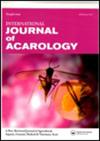Synergistic properties of essential oils of eucalyptus (Eucalyptus globulus) and lemon grass (Cymbopogon flexuosus) against cattle tick, Rhipicephalus microplus
IF 1
3区 农林科学
Q3 ENTOMOLOGY
引用次数: 0
Abstract
ABSTRACT The anti-tick efficacy of eight commercially available essential oils (EOs), viz., Neem (Azadirachta indica), castor (Ricinus communis L.), lemon grass (Cymbopogon flexuosus), eucalyptus (Eucalyptus globulus), curry leaves (Murraya koenigii), garlic (Allium sativum), sage (Salvia officinalis), and rosemary (Rosmarinus officinalis), was screened in vitro against Rhipicephalus microplus ticks. Each of the EOs were diluted in 2% Triton X-100 and 10% ethanol to prepare working concentrations and were tested against IVRI-I strain of Rhipicephalus microplus. The mortality, egg masses, and inhibition of oviposition (IO) were used to determine treatment effectiveness. The EOs of C. flexuosus, E. globulus, S. officinalis, and R. officinalis showed more than 95% efficacy at the tested concentrations. While, EOs of A. indica, R. communis, M. koenigii, and A. sativum were found 16–33% efficacious. Six different combinations of the most effective EOs (C. flexuosus and E. globulus) were prepared and tested for anti-tick activity. The combination C, F, and H showed 100% mortality at 4% concentration. The combination H was found more economical than ivermectin for animal treatment indication that it can be used effectively for the development of potent antitick formulation for the management of tick populations.桉树(eucalyptus globulus)和柠檬草(Cymbopogon flexuosus)精油对牛蜱的增效作用
摘要研究了印楝(Azadirachta indica)、蓖麻(Ricinus communis L.)、柠檬草(Cymbopogon flexuosus)、桉树(eucalyptus globulus)、咖喱叶(Murraya koenigii)、大蒜(Allium sativum)、鼠尾草(Salvia officinalis)和迷迭香(Rosmarinus officinalis) 8种市售精油(EOs)对微头蜱的体外防蜱效果。分别用2% Triton X-100和10%乙醇稀释至工作浓度,并对微小鼻头菌ivri -1株进行抑菌试验。用死亡率、卵量和产卵抑制(IO)来确定治疗效果。在不同浓度下,弯曲梭菌、球形梭菌、officinalis和officinalis的体外抑菌效果均大于95%。而对籼稻、白花田鼠、白花田鼠和黄田鼠的抑菌效果为16 ~ 33%。制备了6种不同组合的最有效蜱虫制剂(弯曲蜱虫和球状蜱虫),并对其抗蜱活性进行了测试。C、F和H在浓度为4%时死亡率为100%。在动物治疗方面,联合H比伊维菌素更经济,这表明它可以有效地用于开发有效的抗蜱制剂,以管理蜱虫种群。
本文章由计算机程序翻译,如有差异,请以英文原文为准。
求助全文
约1分钟内获得全文
求助全文
来源期刊
CiteScore
2.20
自引率
9.10%
发文量
60
审稿时长
6-12 weeks
期刊介绍:
The International Journal of Acarology has a global readership and publishes original research and review papers on a wide variety of acarological subjects including:
• mite and tick behavior
• biochemistry
• biology
• control
• ecology
• evolution
• morphology
• physiology
• systematics
• taxonomy (single species descriptions are discouraged unless accompanied by additional new information on ecology, biology, systematics, etc.)
All submitted manuscripts are subject to initial appraisal by the Editor. If the English is not of a quality suitable for reviewers, the manuscript will be returned. If found suitable for further consideration, it will be submitted to peer review by independent, anonymous expert referees. All peer review is single blind.

 求助内容:
求助内容: 应助结果提醒方式:
应助结果提醒方式:


